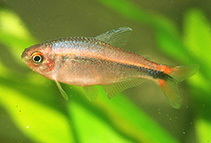| Family: |
Characidae (Characins; tetras), subfamily: Stethaprioninae |
| Max. size: |
2.38 cm SL (male/unsexed) |
| Environment: |
benthopelagic; freshwater |
| Distribution: |
South America: Brzail. |
| Diagnosis: |
This species is distinguished from all its congeners, except Hyphessobrycon agulha, H. clavatus, H. herbertaxelrodi, H. klausanni, H. loretoensis, H. lucenorum, H. margitae, H. metae, H. mutabilis, H. peruvianus, H. wadai, by having the lower half of body deeply pigmented with dark chromatophores, mainly above the anal fin, forming a broad, diffuse, dark midlateral stripe (vs. no longitudinal stripe, narrow stripe starting approximately at vertical through the dorsal-fin origin, or relatively narrow, well-defined, dark midlateral stripe on body extending from the posterior margin of the eye to the middle caudal-fin rays); with high concentration of dark chromatophores along unbranched dorsal-fin rays and distal portions of the two or three subsequent branched rays (vs. dark chromatophores absent or, when present, only scattered on fin) (Ref. 128641). |
| Biology: |
Found where water is transparent and the river bottom is composed of stones, sand and a moderate amount of vegetal debris. The type locality which is a hydroelectric reservoir (PCH Divisa) built in 2010 in the Rio Formiga, occupy an area of 6·8 km2. Before the dam was built, this place would have resembled the adjacent up and downstream areas of the river, i.e. a relative narrow (10–15 m wide) and shallow (maximum depth approximately 1·8 m in some sites) river stretch, with rapid waters and rifles. Stomach contents revealed a diet based on filamentous algae (c. 10%), vascular plant tissue (c. 6%), microcrustaceans (c. 10%), Chironomidae larvae (c. 10%) and Ephemeroptera nymphs (c. 64%). It may be considered an omnivorous species based on the main food resources exploited, but may have tendency toward invertivory. Approximately 50% of the analysed specimens had parasitic isopods (Cymothoidae) associated with the tongue. Specimens with this parasites exhibited a bag-shaped lower jaw, tongue atrophy and softening of the cartilaginous tissues (Ref. 128641). |
| IUCN Red List Status: |
Not Evaluated (N.E.) Ref. (130435)
|
| Threat to humans: |
harmless |
Source and more info: www.fishbase.org. For personal, classroom, and other internal use only. Not for publication.

